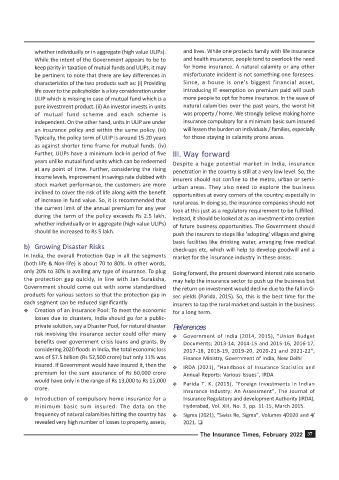Page 37 - Insurance Times February 2022
P. 37
whether individually or in aggregate (high value ULIPs). and lives. While one protects family with life insurance
While the intent of the Government appears to be to and health insurance, people tend to overlook the need
keep parity in taxation of mutual funds and ULIPs, it may for home insurance. A natural calamity or any other
be pertinent to note that there are key differences in misfortunate incident is not something one foresees.
characteristics of the two products such as: (i) Providing Since, a house is one's biggest financial asset,
life cover to the policyholder is a key consideration under introducing IT exemption on premium paid will push
ULIP which is missing in case of mutual fund which is a more people to opt for home insurance. In the wave of
pure investment product. (ii) An investor invests in units natural calamities over the past years, the worst hit
of mutual fund scheme and each scheme is was property / home. We strongly believe making home
independent. On the other hand, units in ULIP are under insurance compulsory for a minimum basic sum insured
an insurance policy and within the same policy. (iii) will lessen the burden on individuals / families, especially
Typically, the policy term of ULIP is around 15-20 years for those staying in calamity prone areas.
as against shorter time frame for mutual funds. (iv)
Further, ULIPs have a minimum lock-in period of five III. Way forward
years unlike mutual fund units which can be redeemed
Despite a huge potential market in India, insurance
at any point of time. Further, considering the rising penetration in the country is still at a very low level. So, the
income levels, improvement in savings rate clubbed with
insurers should not confine to the metro, urban or semi-
stock market performance, the customers are more
urban areas. They also need to explore the business
inclined to cover the risk of life along with the benefit opportunities at every corners of the country, especially in
of increase in fund value. So, it is recommended that rural areas. In doing so, the insurance companies should not
the current limit of the annual premium for any year
look at this just as a regulatory requirement to be fulfilled.
during the term of the policy exceeds Rs 2.5 lakh,
Instead, it should be looked at as an investment into creation
whether individually or in aggregate (high value ULIPs) of future business opportunities. The Government should
should be increased to Rs 5 lakh.
push the insurers to steps like 'adopting' villages and giving
basic facilities like drinking water, arranging free medical
b) Growing Disaster Risks check-ups etc, which will help to develop goodwill and a
In India, the overall Protection Gap in all the segments market for the insurance industry in these areas.
(both life & Non-life) is about 70 to 80%. In other words,
only 20% to 30% is availing any type of insurance. To plug Going forward, the present downward interest rate scenario
the protection gap quickly, in line with Jan Suraksha, may help the insurance sector to push up the business but
Government should come out with some standardised the return on investment would decline due to the fall in G-
products for various sectors so that the protection gap in sec yields (Parida, 2015). So, this is the best time for the
each segment can be reduced significantly. insurers to tap the rural market and sustain in the business
Y Creation of an Insurance Pool: To meet the economic for a long term.
losses due to disasters, India should go for a public-
private solution, say a Disaster Pool, for natural disaster References
risk involving the insurance sector could offer many
Y Government of India (2014, 2015), "Union Budget
benefits over government crisis loans and grants. By Documents; 2013-14, 2014-15 and 2015-16, 2016-17,
considering 2020 floods in India, the total economic loss 2017-18, 2018-19, 2019-20, 2020-21 and 2021-22",
was of $7.5 billion (Rs 52,500 crore) but only 11% was Finance Ministry, Government of India, New Delhi
insured. If Government would have insured it, then the
Y IRDA (2021), "Handbook of Insurance Statistics and
premium for the sum assurance of Rs 60,000 crore Annual Reports: Various Issues", IRDA
would have only in the range of Rs 13,000 to Rs 15,000
Y Parida T. K. (2015), "Foreign Investments in Indian
crore.
Insurance Industry: An Assessment", The Journal of
Y Introduction of compulsory home insurance for a Insurance Regulatory and development Authority (IRDA),
minimum basic sum insured: The data on the Hyderabad, Vol. XIII, No. 3, pp. 11-15, March 2015.
frequency of natural calamities hitting the country has Y Sigma (2021), "Swiss Re, Sigma", Volumes 4/2020 and 4/
revealed very high number of losses to property, assets, 2021. R
The Insurance Times, February 2022 37

